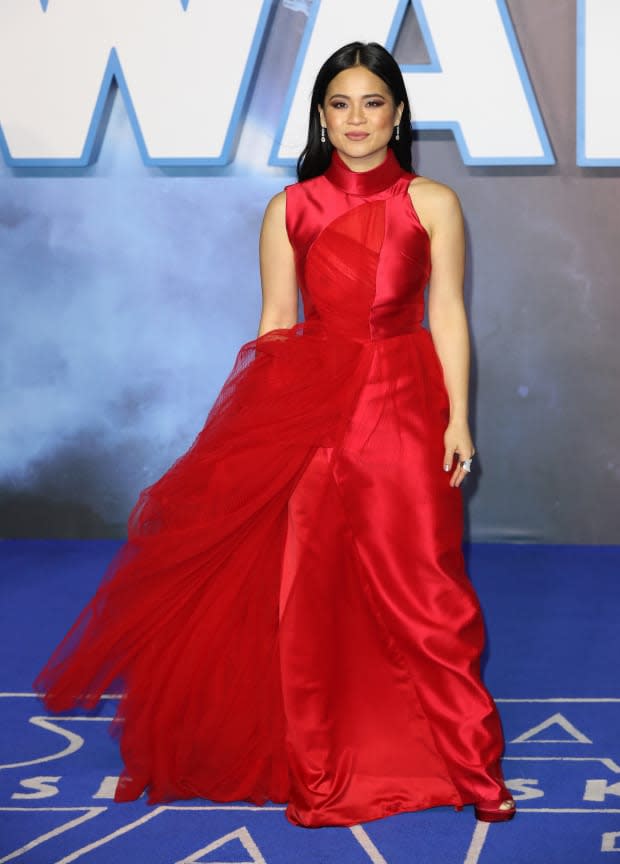Celebrities and Their Stylists Are Using the Red Carpet to Lift Up Designers of Color
The many outfit changes afforded by a promotional cycle gives talent the opportunity to put the spotlight on underrepresented communities in fashion.

Ask any celebrity stylist: The red carpet is where cultural moments are made. I mean, it indirectly created Google Images — and without it, the world's meme supply would drastically decrease. But beyond the viral moments, there's a well of potential impact that celebrities and their stylists are only beginning to really tap into. Increasingly, we're seeing some recognize the reach and power a solid look can have and have begun using award shows, press tours, brand campaigns and other media appearances to spotlight traditionally underrepresented designers.
Most recently, Kelly-Marie Tran, styled by Wayman Bannerman and Micah McDonald, exclusively wore Asian designers while promoting "Star Wars: The Rise of Skywalker". Gemma Chan, styled by Rebecca Corbin-Murray, did the same in 2018, when she was promoting "Crazy Rich Asians."

"The world of fashion is quite larger than the handful of mainstream designers who are to be considered household names — and it's constantly growing," Bannerman tells Fashionista. "Kelly is not only very proud of her heritage, she's also very vocal about being an advocate for more inclusion of people of color in entertainment spaces. We believe there's room for everyone, and once we start accepting more designers, we can really have fun with fashion."
Tran's recent "Star Wars" press junket — during which she wore custom pieces by Jason Wu, Prabal Gurung and Adeam's Hanako Maeda — is but the most recent example of how the styling duo has worked with talent to showcase designers with diverse backgrounds. They've put Tessa Thompson in Robert Wun boots for the 2019 Vanity Fair Oscars party; styled Alexandra Shipp in custom Christopher John Rogers for the premiere of "Dark Phoenix"; and placed custom Jason Wu on Regina King for the 2019 Emmys.
"We find it important for public figures to use big moments, such as red carpets or events, to showcase the work of underrepresented designers because it opens up conversations that get people prepared for change," McDonald explains. "Designers are able to have their work on a larger platform, which allows them to reach a variety of new audiences."

Over the past few years, we've seen both stylists and talent be more vocal when they intentionally choose to wear pieces from these brands — like how Issa Rae and Tracee Ellis Ross hosted award shows wearing exclusively Black designers (the 2018 CFDA Awards and AMAs, respectively). Wayman + Micah say that collaborating on a wardrobe that highlights designers of color is a learning opportunity for everyone involved.
"These press tours start the conversation with our clients to see how they feel about trying to place different designers and getting their feedback on what that means to them, who they’d like to see, etc.," Bannerman says. "[It's] very insightful."
Another important reason why stylists work with underrepresented designers in this particular space? To ensure that these creatives are acknowledged for their contributions to the industry, which can also be one that steals and appropriates with little to no consequence.

"We're giving them an opportunity and a platform for their art to be seen by the world, and get due credit," says stylist Brittany Diego, who recently placed singer DaniLeigh in No // Otra, a streetwear label designed by two Latinx artists in Los Angeles. And for a Black Radiance makeup campaign, she pulled a gown by the Nigerian designer Anit Cuts for TV personality Jessie Woo.
For Diego, it's about being a conduit in an industry that's hyper competitive and gatekept.
"The main obstacle between underrepresented designers getting their designs on red carpets is access to celebrities and influential public figures, and we as stylists bridge that gap," she says. "I love connecting directly to the designers when I'm pulling for a client. I get to hear the stories behind the clothing that you don't get when you're pulling from a rack at a showroom."
This awards season, Venk Modur styled Oscar-nominated filmmakers Smriti Mundhra and Sami Khan, who competed in the Documentary Short Subject category for their film "St. Louis Superman". They wore Abu Jani Sandeep Khosla, Ashwin Thiyagarajan, Gravitas by Lisa Sun, and House of Wasee for events leading up to, and including, the Academy Awards.
"[Their] work is spectacular and we need to diversify this fashion conversation," Modur says. "We're seeing more Asians in front of the camera and they want to proudly represent their heritage. Using European design with eastern artistic stitching is a beautiful way to fuse cultures and really make quite a lovely statement on how we live in a global community."
Besides opening doors for emerging designers in terms of access and exposure, today's stylists also play a pivotal role in guaranteeing that the fashion of the future is as diverse and representative as it can be.
"The biggest impact we can hope for is [for] the younger generations," McDonald says. "The ones who might feel like they have something to contribute, but don’t feel it’s possible since they haven’t seen someone who looks like them accomplish it. We hope they see inclusivity and representation on the red carpets and press tours, and know that they too can do it."
Want more Fashionista? Sign up for our daily newsletter and get us directly in your inbox.